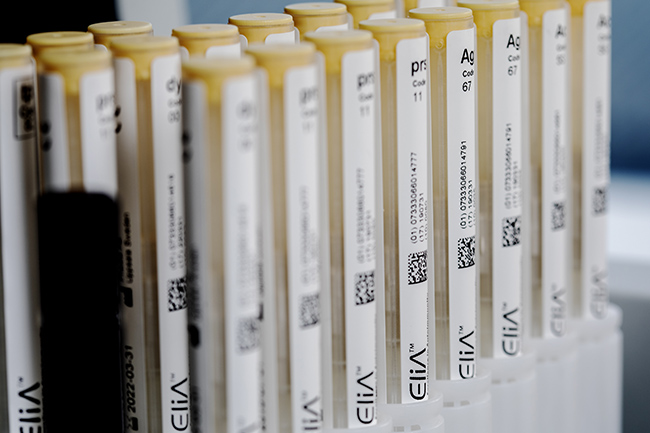Published: May 2025
Medically reviewed by:
Gary Falcetano, PA-C, AE-C
In recent decades, there has been an increasing spotlight on food allergies, prompting a heightened overall awareness of the subject. Characterized by the immune system’s adverse reactions to certain foods and nestled within the broader realm of “adverse food reactions,” food allergies can cause a wide variety of symptoms, sometimes making diagnosis difficult.

Food allergy impact
Food allergy affects approximately 3-10% of children and up to 10% of adults and it can have a significant impact on their quality of life.1
Diagnosis of food allergies often comes with mental, emotional, and social struggles for patients and caregivers. Patients may feel anxious about managing their allergies and the risk of reactions. Kids with food allergies might get bullied or feel left out at school. And caregivers can feel isolated and anxious about potential severe reactions.2
Why primary care is key
Primary care providers play a pivotal role in the early stages of diagnosing and managing food allergies, particularly in conducting initial blood tests and referring patients to allergists when necessary, ensuring that patients receive specialized care and individually tailored treatment plans.3,4
As the first point of contact for many patients who experience food allergy symptoms, you can help them navigate the full diagnostic and treatment journey. Specific IgE testing can help you uncover the full picture of your patient's food allergy symptoms and ultimately enhance their outcomes.
Importance of food allergy diagnosis
Adverse food reactions are categorized into IgE-mediated, non-IgE mediated, and other reactions.1 Accurate diagnosis, especially distinguishing IgE-mediated reactions, is fundamental for developing an effective management plan.1
IgE-mediated food reaction |
Non-IgE-mediated food reaction |
|---|---|
| An immune system reaction | Not an immune system reaction |
| Designated a food allergy | Designated a food intolerance |
| Typically rapid onset of symptoms (within two hours) | Typically slower onset of systems |
| Symptoms are reproducible with re-exposure | Symptoms not as consistently reproducible |
| Symptoms can involve skin, GI tract, respiratory, cardiovascular systems, among others | Symptoms primarily localized to the gut |
Three steps to a systematic approach
These steps walk you through a systematic approach to help diagnose, treat and manage your patient’s allergies by leveraging ImmunoCAP™ Specific IgE blood tests to aid their allergy diagnosis.
Step 1: Perform an allergy-focused history & physical examination
In patients with suspected IgE-mediated food allergy, begin with a detailed medical history to identify potential allergens, guiding the choice of allergen tests based on history, symptoms and triggers.1
Here are just a few as an example. You can find full lists of key questions in a variety of places, including the 2023 EAACI food allergy diagnosis guidelines.
- When did manifestations start?
- Were symptoms immediate?
- Was the suspected food ingested, touched or inhaled?
- Is the patient sensitized to pollens, latex, or dust mites?
- Are atopic dermatitis, seasonal or perennial allergic rhinitis, asthma, and urticaria present?
- Do parents or siblings have atopic disease?
Step 2: Search for potential allergen(s) using ImmunoCAP Specific IgE tests
Using allergen specific IgE testing, guided by the patient's history, you can determine IgE sensitization against allergen extracts from the potential culprit allergens.1
Nine allergen families account for 90% of food allergic reactions, making their identification essential for accurate diagnosis and effective management.5
Cow's milk
Egg white
Shell fish
Fish
Wheat
Soy
Tree-nut
Peanut
Sesame
The use of ImmunoCAP™ Specific IgE tests to detect antibodies to these allergens may help with diagnostic accuracy and the development of targeted management plans for patients.
After correlating a suspicious clinical history with presence or absence of specific IgE antibodies, clinicians are able to form a more precise diagnosis and develop patient specific management plans including appropriate specialist referrals.
You can always find the most up-to-date test codes for allergen diagnostic testing, including those with milk, egg, peanut, tree nut, wheat, and sesame seed with allergen component reflexes, in our Lab Ordering Guide (LOG).
Step 3: Develop a management plan
After making a diagnosis, providers may provide patients and caregivers with avoidance recommendations and prepare them for managing their allergic symptoms, including anaphylaxis, if applicable. A well-established management plan includes regular follow up to evaluate sensitizations and adjust management as necessary.
Find additional information on ImmunoCAP Specific IgE testing to aid in food allergy diagnosis.



